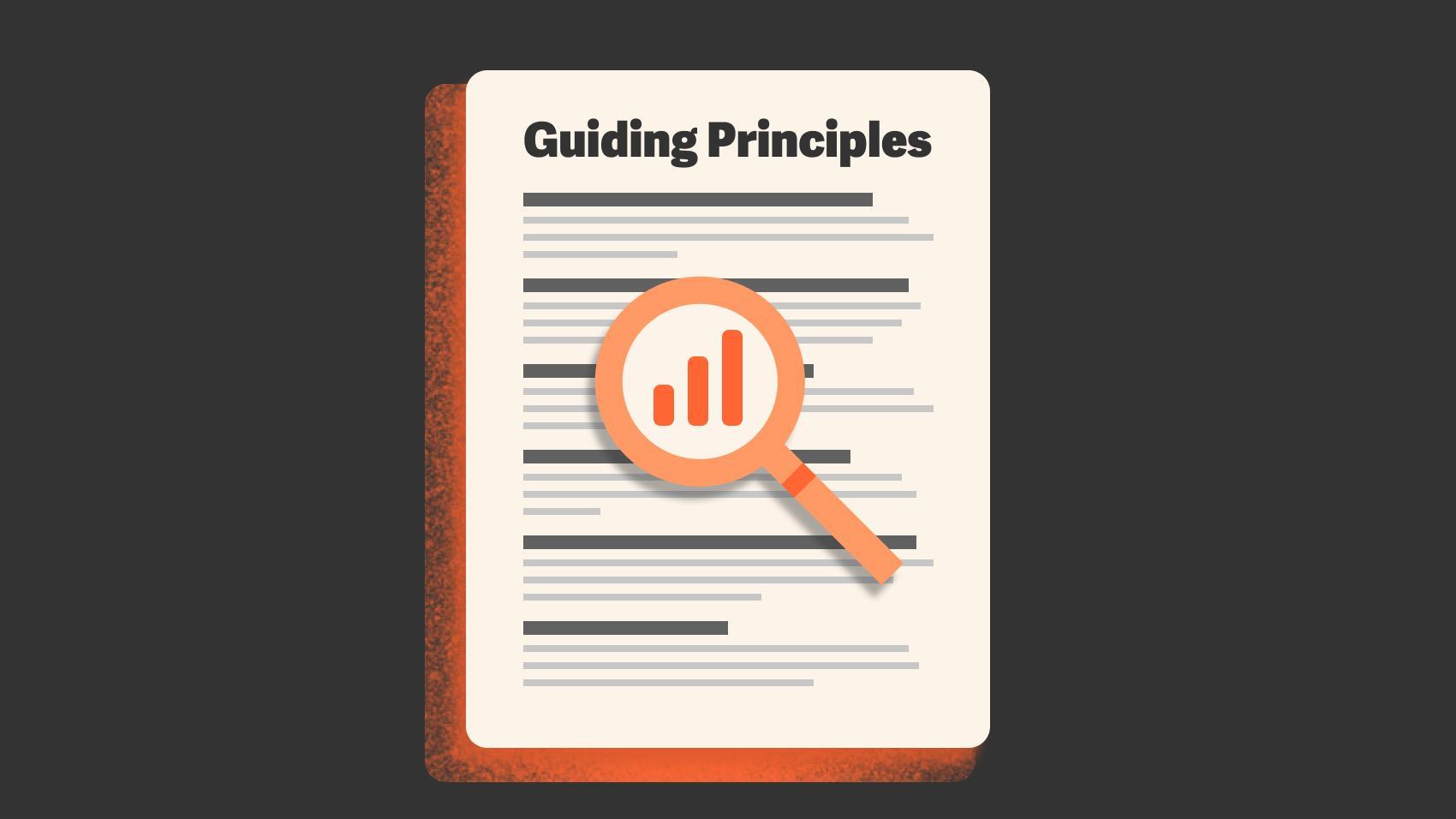Strategic Planning: How to Create Guiding Principles for Your Internal Auditing Team

To successfully implement a strategic plan for your internal auditing function, the first step is to craft a vision and mission. As I mentioned in the first post of this blog series on strategic planning, I believe that having a clear vision and mission provides a North Star for your strategic journey and can help you stay on target.
Now that you’ve completed step one, you’re ready to tackle the next step in developing a strategic plan: guiding principles. Let’s dive in.
Culture: A key part of guiding principles
Most strategic planning courses and textbooks include discussions about vision and mission statements as critical elements of strategic plans. An aspect that is not always included, but one that I have embraced as essential, is the idea of guiding principles. Your vision and mission will be driven by many aspects of your strategic plan, including strategy pillars that I will discuss in part three of this blog series. But your vision and mission will be influenced the most by your culture. I would even say that your vision and mission's success depends on your culture.
So what do we mean by culture? Some like to define culture as "the way we do things here." I think of culture in the context of the values and beliefs that drive fundamental behaviors. How we believe and what we value ultimately leads to behaviors that drive the execution of everything we do.
Every organization has a culture. Some cultures reflect a key leader, and others materialize organically independently. Still, others are methodically directed. In my opinion, cultures that are a manifestation of a key leader or that emerge organically are susceptible to unhealthy characteristics. Healthy cultures are actively managed. Guiding principles help us nurture the culture that will facilitate our vision and strategic intent.
Guiding principles then are the codification of what we believe and value and how we are expected to behave as we execute our strategies. In essence, guiding principles help to describe and manage our culture. Once we have defined the guiding principles that will develop our culture, we now have a framework for holding people accountable and measuring our culture.
Guiding principles in action
Below are the eight guiding principles my team has currently defined. They articulate what we believe and value most (these are specific to my team, and yours will be different to reflect the culture you need to manage and nurture). As you review them, note how they align with our dream (i.e., our vision).
- We are obsessed with service to stakeholders
- We strive to deliver excellence in everything we do
- We innovate because growing complacent in our mission and stale in our abilities is unacceptable
- We are professionals in carrying out our responsibilities
- We understand the business we are engaged in and how the organization we serve intends to achieve its strategies
- We challenge ourselves by setting accretive and difficult but achievable performance goals for ourselves
- We are accountable for our performance and assess ourselves objectively and with integrity
- We are team players who support our leaders and teammates
A caveat with guiding principles is that they tend to be subject to interpretation, which can cause confusion and inconsistent application. This was the case for my team's guiding principles. I felt it was important to have a common understanding of what each of these principles was meant to convey. Therefore, for each principle, there is additional language that defines the expectation in more detail and potential metrics we will use to monitor our progress and adherence.
Here are the detailed comments that support clarity for our guiding principles:
1. We are obsessed with service to stakeholders
- Nothing else matters if our stakeholders are not well served and do not see value in what we deliver
- We must understand what stakeholders expect from us
- Relationships are critical to our success
- We need to see the world from our stakeholders’ perspectives and be empathetic toward their challenges (i.e., walk a mile in their shoes)
2. We strive to deliver excellence in everything we do
- Excellence is a mindset (i.e., an involuntary reflex)
- Excellence does not equal perfection
- Excellence is facilitated by how we prioritize (i.e., how we plan so that we get the most out of the resources that have been entrusted to us)
- Preparation (i.e., practice) is a precursor to excellence
- All-encompassing—this applies to every task we carry out (draft reports, meetings, closing calls, checkpoints, presentations, relationships, final work product, etc.)
3. We innovate because growing complacent in our mission and stale in our abilities is unacceptable
- We must nurture our motivation in order to stay mentally sharp and engaged
- We must embrace technology as a facilitator of our value proposition
- We must grow and nurture our technical skills to stay current with the trends in our profession
- We maintain an innovative and entrepreneurial mindset (i.e., we pay our own way)
- Risk-taking is necessary for fulfilling our value proposition (we take informed, calculated risks and accept some failure as a cost of risk-taking)
- Everything we do must have the potential to add value for our stakeholders
- We should have a mindset to make it difficult for the person who inherits our role to “leave it better than they found it”
4. We are professionals in carrying out our responsibilities
- It is important that we refine our skills to demonstrate proficiency in performing our duties (through professional certifications and/or advanced training and education)
- We are self-developers and continuous learners (i.e., we do not relinquish this responsibility to others or rely solely on the resources of others for our own development)
- We are individually the owners of our destiny and make the personal sacrifices and investments necessary to achieve our professional goals
- We are self-supervising, self-motivated, and self-aware
- We recognize the need to hold ourselves to high standards so that our integrity is beyond reproach
- Regardless of role, we lead by example
- We understand that our professional success is a direct outcome of personal effort AND results (i.e., we can’t just try hard—we must deliver)
5. We understand the business we are engaged in and how the organization we serve intends to achieve its strategies
- We must understand the fundamentals of the industry or industries we’re in and how value is created within
- We must understand the key value drivers of the business (e.g., processes, systems, etc.)
- We must understand how the business intends to achieve its goals and be aware of associated risks
- We have a strategic mindset, continually adjusting our value proposition to stay ahead of the needs of our stakeholders
6. We challenge ourselves by setting accretive and difficult, but achievable, performance goals for ourselves
- We are self-challenging—no one challenges us like we challenge ourselves
- We set a high bar for ourselves because even if we do not achieve our goal, it makes us better
- We articulate our goals using the SMART system
- Aligned with vision, mission, and organizational goals
7. We are accountable for our performance and assess ourselves objectively and with integrity
- We measure our progress toward our vision
- We are honest with ourselves (i.e., we don’t rationalize our way into or out of accountability)
- When we do not meet the mark, we accept the consequences and move forward having learned from our failure
- When we achieve success, we will celebrate
8. We are team players who support our leaders and teammates
- We recognize we each have a role to play, and that role may change over time and from project to project
- We are supportive and positive in our words and deeds (i.e., actions and mindset) toward one another
- We resolve conflict through appropriate channels and methods
- We show respect to everyone, all the time, even when it is not reciprocated
- We participate in volunteer activities in order to make a positive contribution toward a healthy organizational culture
Set it and evaluate it: Regularly review your guiding principles
A final note and caution about guiding principles: They’re only as good as their consistent application. It takes leadership to achieve the objectives of guiding principles (i.e., a healthy and sustainable culture that supports your vision and mission). As a team, we review our guiding principles at least once a year. I personally review them throughout the year and make adjustments as warranted. I also review our guiding principles (along with our vision and mission) with each new hire during onboarding. And I monitor our progress with my leadership team.
As I mentioned earlier, healthy and sustainable cultures require active management. Guiding principles are just words on paper unless leaders live them and promote them as a core strategic enabler.
Now that you understand what guiding principles are and how to create them for your team, you’re ready for the next part of your strategic planning journey—strategy pillars. Check out part three of this blog series here. If you missed the first part on crafting your team’s vision and mission, you can check it out here.
Continuous Monitoring vs. Continuous Auditing: Understanding Modern Audit Analytics
Discover the difference between continuous monitoring and continuous auditing, and why you need both in your audit process. On top of that, audit analytics have become table stakes and you need to determine how to integrate analytics into your program—or you're behind.


